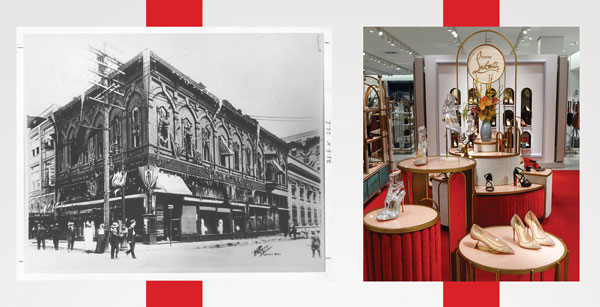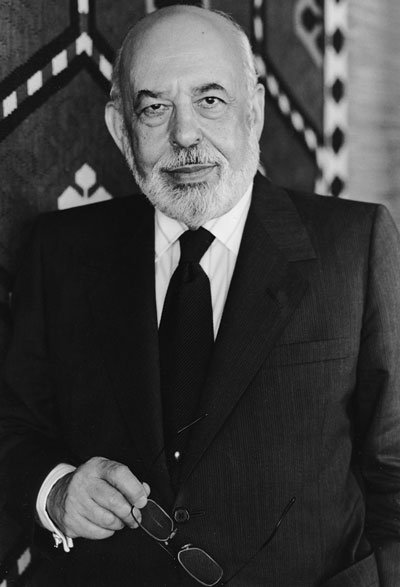
Window shopping in downtown Dallas took on a whole new meaning as one perused the displays at the flagship store of Neiman Marcus in the 1970s. Many downtown stores were suffering declining sales as the concept of shopping malls moved sales to outlying communities around the major metropolitan areas. However, Neiman’s continued to flourish because of its unique brands of high-end merchandise and customer service. At the helm of the store, of course, was the ubiquitous Stanley Marcus.
The history of the store reveals its inception was the result of a partnership between Stanley’s father, Herbert Marcus, and his uncle, Al Neiman. Their idea was to fill a niche in Dallas for exclusive clothing that was available as ready-to-wear, rather than custom made. The store offered tailoring only for alterations, doing away with raw fabric sales. One of Stanley’s early contributions to the store’s image was his insistence that they carry no brands that were available at any other store in Dallas.
While neither of the founding partners had completed high school, Stanley graduated from Harvard in 1926. He immediately went to work in the store as a floorman. By 1929, he was merchandising manager for all apparel divisions. The business philosophy his father often quoted and Stanley used at the opening phrase of his book Minding the Store was, “There is never a good sale for Neiman Marcus unless it is a good buy for the customer.” Stanley could be seen in the store drawing just as much satisfaction in the closing of a $10 sale as he would from a $500,000 sale, if he knew he had genuinely met the customer’s need.
Stanley spent a lot of time traveling between Dallas and the fashion centers of New York, but his influence was much greater than this continent, as at one time he was considered Dallas’ most internationally famous citizen. In Minding the Store, he wrote, “Some people become stagestruck at an early age and never recover. From the time of my initial trip to Europe in 1925 I was ‘Europe Struck.’ And although I shall never duplicate the thrill of my first visit to Paris or London, forty-nine years and fifty trips later my pulse quickens when the plane touches down at Orly or Heathrow.” Rumors abounded after WWII that Stanley was being considered during the Eisenhower, Kennedy and Johnson administrations for an appointment as ambassador to France. Though the rumors may or may not have been true, he did receive a call from the Kennedy administration for consideration as ambassador to South America, which he declined.

Innovative is hardly a strong enough description for the marketing genius that was Stanley Marcus. He started Fortnight at Neiman Marcus by saying, “We are going to do something no other retailer has ever done. We are going to disclose our fall promotional program six months in advance.” Retailers normally do not reveal such future plans, but Stanley’s plans were so thorough (and perhaps so outlandish) that he felt no other retailer would be able to keep up. The promotions were international in nature and a tremendous success.
Advertising in nationwide publications was another successful venture for Neiman Marcus under Stanley’s leadership. And who is not familiar with the “his and hers” items in the Christmas catalog, things such as airplanes, submarines and jaguars — his was a Jaguar roadster, hers was a jaguar coat? One promotion was captioned “Junk for Christmas,” and it was actually a Chinese junk (boat) offered for $11,500. To the surprise of Stanley and the rest of the store, they sold eight of them, and delivered them to various bodies of water around the world!
Stanley had a reputation for having an opinion, and newspapers were interested in what he had to say. After the Kennedy assassination in Dallas, Stanley had an editorial published in paid space in both of the local newspapers. While it could have been titled, “What’s Wrong with Dallas?” Stanley chose a much more positive, “What’s Right With Dallas?” as the title and theme. The article was reprinted in numerous editorial markets across the world, and the editorial comments were favorable.

There is a portrait of Stanley that was taken in 1974 by Shelly Katz. Katz was a renowned photojournalist, and it shows in the photograph because the photo tells a story. Stanley’s eyes squint with a mischievous glimmer. His smile is not quite complete, as if he paused in mid-phrase to see and hear the response to what he just said. His eyeglasses are held gently between the thumb and forefinger of his left hand, because it appears he wants his audience to see the genuineness of his neatly groomed, bearded face.
Such was Stanley. Whether it was a mink coat, a pair of tennis shoes, or just an idea, the man was going to sell
you something.
Sources:
1. Britannica.com/biography/Stanley-Marcus.
2. Minding the Store by Stanley Marcus.
Written by Bill Smith

You must be logged in to post a comment.